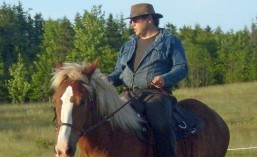2014 Edible Wild Food Course
Location: Northeast Nova Scotia, Twa Corbies Hollow, approx. 1 hr from New Glasgow and Antigonish
Date & Time: June 7, 0900 – 1800
Cost: $100 per person
Reserve Place: $35
Contact: twa.corbies.hollow@gmail.com
Course Description: Most people know there are wild foods in the meadows and woods, but they don’t know how to identify them. Even fewer know how to harvest and use them. Some are even afraid of them. According to David Arora, author of Mushrooms Demystified: “There are few things that strike as much fear in your average [person] as the mere mention of wild mushrooms . . . [But] once you know what to look for, it’s about as difficult to tell a deadly Amanita from a savory chanterelle as it is a lima bean from an artichoke.” This would apply to wild plants, as well. And with some reason, for there are plenty of things that are poisonous. Yet, in North America there are only a handful of deadly mushrooms, and most herbs that are toxic also taste foul enough you wouldn’t to eat them. Having grown up up in the backwaters of the bayou country, and later lived a significant portion of my life in the Alaskan wilderness, I learned to rely heavily on Nature’s wild foods. Now, when venturing into the bush, I don’t see an empty place where survival would be a struggle. I see a place of plenty where a clever person could get by comfortably. And this is a skill you can learn, too.
There is no “perfect time” to pursue wild foods. Some are best in spring, others midsummer, and others even into early winter. This course will take place in late summer which provides several advantages: (1) it is after most biting insects have gone, (2) it is a prime time for many late season wild foods, and (3) many early season wild foods can still be found and identified. Students will learn to identify, harvest and use a number of wild Maritime edible foods, including some of the easier-to-identify mushrooms, cattails and various wild herbs and berries. Of special interest will be boletes, cattails, wild mint, sorrel and sumac, edible tree leaves, elderberries, useful tea sources and calorie sources. We will cover how to identify these foods, testing foods for edibility and reaction, and extracting nutrients from those foods that do not readily give up their bounty (such as from wild tubers like burdock and cattail).
Course begins at 0900 Saturday, August 24 and concludes at 1800 the same day.
Course Requirements: Dress appropriate to warm weather, but it is advised you bring a day pack with rain gear and a sweater as the weather in these parts is very changeable. Also, participants should bring a stout woods knife, folding or straight blade, as well as lunch and snacks. Use hats, sunscreen and bug spray according to personal need, though in August biting insects are rarely any longer much of a problem. Be sure to have tough, sufficient shoes or boots–preferably hikers.
Your teacher: Cliff Seruntine is a certified psychotherapist, shaman, horseman, naturalist and writer. He is also a veteran of some of the most rugged wilderness on Earth–the Alaskan bush–where he dwelt at a remote cabin for many years, as well as the challenges of the hot, steamy Deep South bayou country and the Mojave Desert from Mexico to Arizona, and the high prairies. Cliff now resides on a homestead in the Nova Scotia highlands and brings a polymath, spiritual perspective to Nature experiences and decades of wilderness living know-how to his courses.



